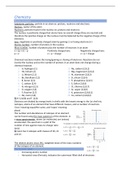Chemistry
Atomic structure
Subatomic particles, particle in an atom ex: protons, neutrons and electrons.
Nucleus, center of the atom
Nucleons, particles found in the nucleus ex: protons and neutrons
The nucleus is positively charged but atoms have no overall charge (they are neutral) and
therefore the positive charge on the nucleus must be balanced by the negative charge of the
electrons.
Ions, negatively or positively charged atom by gaining (-) or losing electrons (+)
Atomic number, number of protons in the nucleus
Mass number, number of protons plus the number of neutrons in an atom
n = (p + n) – p Positively charged ions: Negatively charged ions:
p=e e = p – charge e = p + charge
Chemical reactions involve the losing/gaining or sharing of electrons. Reactions do not
involve the nucleus and so the number of protons in an atom does not change during a
chemical reaction.
1. H, hydrogen (1) 11. Na, sodium (2,8,1)
2. He, helium (2) 12. Mg, magnesium (2,8,2)
3. Li, lithium (2,1) 13. Al, aluminum (2,8,3)
4. Be, Beryllium (2,2) 14. Si, silicon (2,8,4)
5. B, boron (2,3) 15. P, phosphorus (2,8,5)
6. C, carbon (2,4) 16. S, Sulfur (2,8,6)
7. N, nitrogen (2,5) 17. Cl, chlorine (2,8,7)
8. O, oxygen (2,6) 18. Ar, argon (2,8,8)
9. F, fluorine (2,7) 19. K, potassium (2,8,8,1)
10. Ne, neon (2,8) 20. Ca, calcium (2,8,8,2)
Ex K+ (2,8,8) and F- (2,8)
Electrons are divided by energy levels in shells with the lowest energy is the 1st shell etc.
Isotopes, atoms of an element that have different masses, and so number of neutrons
(‘isos’ meaning equal/the same, and ‘topos’ meaning
place)
The number and abundances of isotopes of an element
can be found using the mass spectrum of the element. In
a mass spectrometer, atoms (or molecules) are ionised,
accelerated. The spectrum is a plot of the
number of ions against mass-to-charge ratio
(m/z)
Ex neon has 3 isotopes with masses of 20, 21
and 22.
The relative atomic mass (Ar), weighted mean of the mass numbers
of the isotopes of an element.
The Periodic Table
• Increasing atomic number
• Horizontal rows (Periods), indicates the outermost filled shell of electrons
, • Vertical columns (Groups), similarity in the chemical behaviour of the electrons in
their outermost shell.
Group 1, alkali metals, have one electron in their outermost shell.
Group 2, alkaline earth metals, have two electrons in their outermost shell.
Group 16, elements have six electrons in their outermost shell.
Group 17, halogens, have seven electrons in their outermost shell.
Group 18, noble gases, have a complete outermost shell of electrons.
When a metal Group (ex: Groups 1 and 2) is descended, the elements become more
reactive.
When a non-metal Group (ex: Groups 16 and 17) is descended, the elements become less
reactive.
Name Formula Name Formula Name Formula
Hydrochloric acid HCl Lithium Li+ Bromine Br2
Sodium Na+ Iodine I2
Nitric acid HNO3
Potassium K+ Nitrogen N2
Sulfuric acid H2SO4 Hydrogen H+ Chlorine Cl2
Ethanoic acid CH3COOH Silver Ag+ Hydrogen H2
Ammonium NH4+ Oxygen O2
Name Formula Magnesium Mg2+ Fluorine F2
Ammonia NH3 Calcium Ca2+ Buckminster
Carbon dioxide CO2 Barium Ba2+ fullerene
C60
Zinc Zn2+ (a form of
Carbon monoxide CO carbon)
Copper Cu2+
Methane CH4 Iron (II) Fe2+
Nitrogen dioxide NO2 Iron (III) Fe3+
Nitrogen monoxide NO Aluminum Al3+
Sulfur dioxide SO2
Name Formula
Sulfur trioxide SO3
Fluoride F-
Water H2O
Chloride Cl-
Hydroxide OH-
Symbol State
Nitrate NO3-
S Solid
Oxide O2-
L Liquid
Sulfide S2-
G Gas
Carbonate CO32-
Aq Dissolved in water
Sulfate SO42-
Chemical reactions
The total mass of all the reactants will equal the total mass of all the products.
In an ionic compound, the total number of positive charges must equal the total number of
negative charges. Ex Na2O





